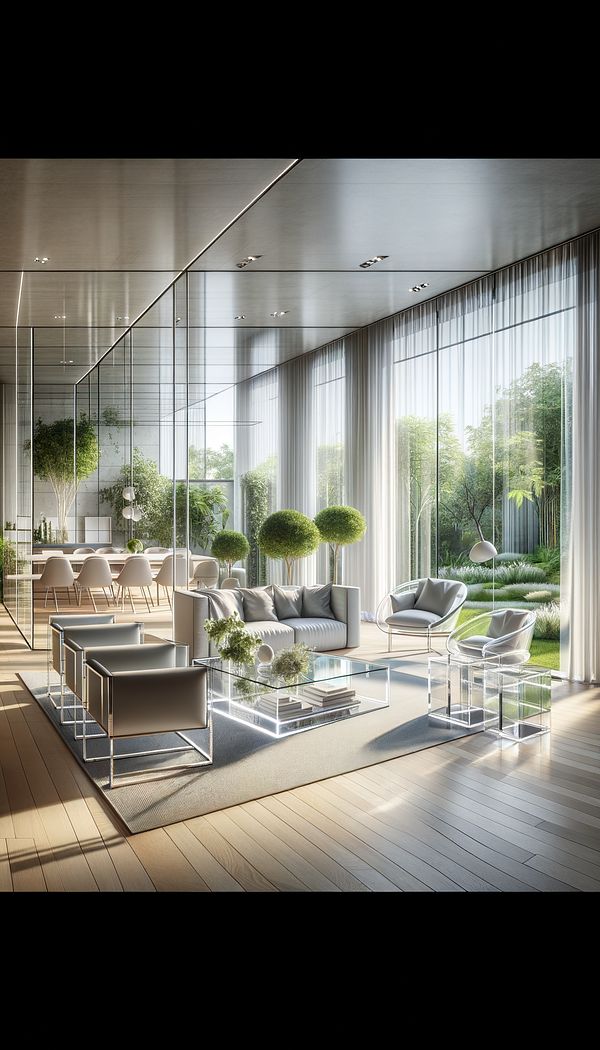What is Transparency?
Transparency in interior design refers to the quality of materials that allows light to pass through them, creating a sense of openness and fluidity.
Description
In the realm of interior design, transparency is a concept that embodies more than just the physical characteristic of materials; it represents an aesthetic quality that can profoundly influence the ambiance, functionality, and perception of a space. By integrating transparent elements, designers are able to manipulate light and views, thereby enhancing the overall spatial experience. This can involve the strategic use of glass, sheer fabrics, or other semi-transparent materials to achieve desired levels of opacity and light diffusion.
Transparency can also imply a seamless blend between indoor and outdoor spaces, making it a key component in designs that prioritize connection with the natural environment. Moreover, it can foster a sense of fluidity and cohesion across different areas of a home or building, breaking down visual barriers and promoting a more inclusive and interactive environment. When applied thoughtfully, transparency can contribute to the creation of visually lighter, more airy spaces that encourage openness and connectivity, both physically and psychologically.
Usage
Transparency is often seen in modern and contemporary interior designs, where large glass windows or walls, translucent curtains, and glass partitions are utilized to maximize natural light and create a seamless transition between indoor and outdoor spaces. It can also be found in the use of transparent furniture pieces, such as glass tables or acrylic chairs, which add to the visual spaciousness of a room.
FAQs
-
How does transparency affect the perception of space?
Transparency can make spaces appear larger and more open by allowing light to flow freely and reducing the visual weight of elements within a space. It encourages visual continuity, which can enhance the perception of fluidity and spaciousness.
-
Is transparency suitable for all types of interior designs?
While transparency can be effectively utilized in many design styles, it is particularly prominent in modern and contemporary interiors that emphasize minimalism, light, and open layouts. However, the degree and manner of incorporating transparency should be carefully considered based on privacy needs, the functionality of spaces, and aesthetic preferences.
-
Can transparency be energy efficient?
Yes, when used strategically, transparent elements like energy-efficient glass can help maximize natural daylight, reducing the need for artificial lighting and contributing to energy savings. However, it's important to consider thermal performance and sun protection to ensure comfort and energy efficiency.
Practical Application
Incorporating transparency into an interior design project requires a thoughtful balance between aesthetic appeal and functionality. Consider the orientation of the space and how natural light interacts with transparent materials throughout the day. Use transparent elements to enhance visual connectivity and create a sense of continuity, while also paying attention to privacy and energy efficiency. Select materials that not only allow light to pass through but also contribute to the overall design aesthetic and complement other elements within the space.
-
Design Styles478 articles
-
Lighting111 articles
-
Window Treatments65 articles
-
Materials & Textiles360 articles
-
Sustainability & Eco-Friendly Design69 articles
-
Boudoir PillowA small, decorative pillow often used for interior decoration.
-
Comb BackA distinctive chair design characterized by a series of vertical spindles that stretch upwards to form a high backrest.
-
High ReliefHigh relief is a sculptural technique where the sculpted elements stand out significantly from the background.
-
LampA lamp is a device that produces light, usually for interior spaces.
-
SegmentalSegmental refers to parts or segments of a whole, often relating to design elements divided into sections.
